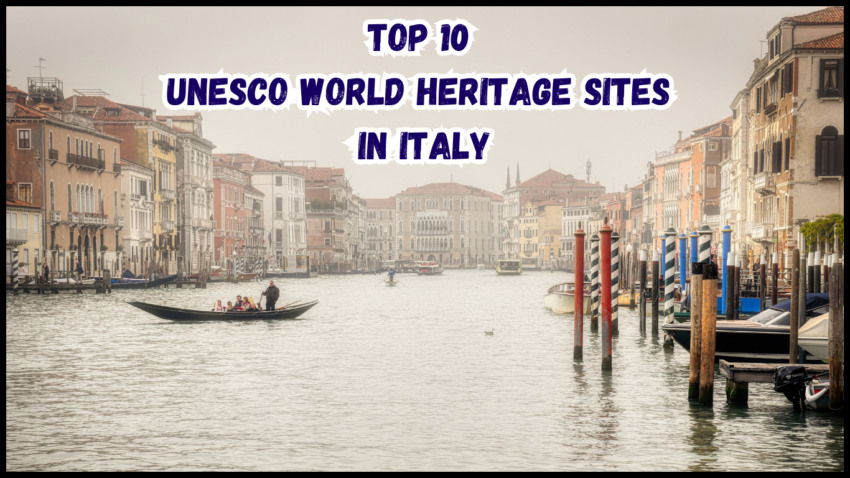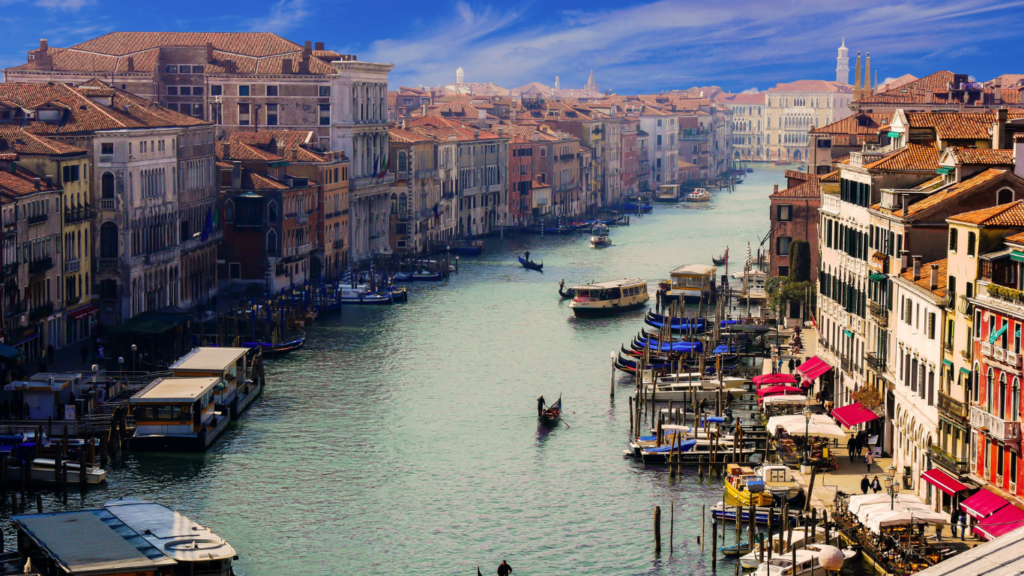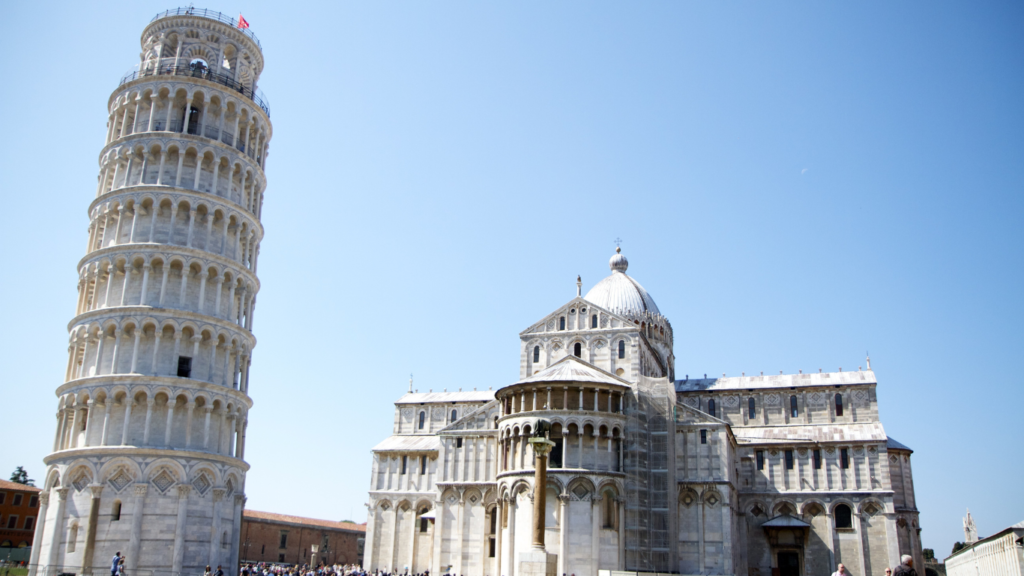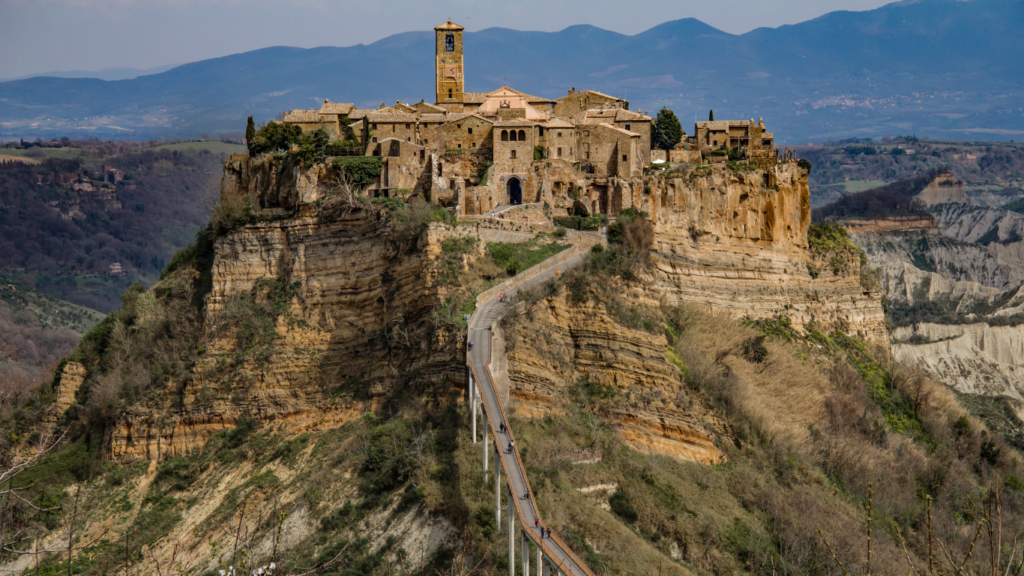
Top 10 UNESCO World Heritage Sites in Italy: Must-See Landmarks and Hidden Gems
Discover the top UNESCO World Heritage Sites in Italy, from iconic landmarks like the Colosseum and Venice to hidden gems like Civita di Bagnoregio and Val d’Orcia. Explore Italy’s rich cultural and natural heritage.
Italy, often called the cradle of Western civilization, boasts an unparalleled wealth of cultural and historical treasures. With its long and storied past stretching back to Ancient Rome, the Renaissance and beyond, Italy has 58 UNESCO World Heritage Sites, the most of any country in the world. From ancient ruins that echo the grandeur of the Roman Empire to stunning medieval cities and breathtaking natural landscapes, Italy’s heritage sites are proof of its timeless appeal.
The country’s UNESCO World Heritage Sites encompass a wide range of attractions, including architectural masterpieces, archaeological wonders and beautiful landscapes that inspire awe. Visitors can explore the iconic Colosseum in Rome, the romantic canals of Venice and the artistic splendor of Florence, as well as lesser-known gems like the ethereal Val d’Orcia or the ancient nuraghi of Sardinia.
What makes Italy truly special is the seamless integration of its cultural and natural heritage into everyday life. While world-famous sites attract millions of tourists each year, hidden gems often offer a more intimate glimpse of the country’s rich history, unique traditions and stunning scenery.
This guide is designed to help you uncover the best of both worlds: the famous sites that define Italy’s heritage and the hidden treasures that reveal its soul. Whether you’re a history buff, art lover or nature admirer, Italy’s UNESCO World Heritage Sites promise an unforgettable journey into the heart of human civilization.
Italy’s Legacy as a World Heritage Leader

Italy holds the title of the country with the most UNESCO World Heritage Sites in the world, with a total of 58 recognized by 2024. These sites are a reflection of Italy’s unique cultural and natural diversity, ranging from ancient ruins and Renaissance art to breathtaking landscapes and geological wonders. Each site is a testament to the country’s rich history, artistic innovation and deep respect for heritage preservation.
In global rankings, Italy consistently stands out as a leader in heritage conservation and promotion. Its contribution to UNESCO’s mission to protect and celebrate human and natural achievements is widely recognized. Italy’s sites not only highlight its historical significance but also demonstrate its role as a beacon of cultural identity and sustainable tourism.
What sets Italy’s UNESCO World Heritage Sites apart is their incredible diversity:
- Cultural Sites: Italy’s history is deeply intertwined with the rise and fall of civilizations. Ancient structures like the Colosseum and Pompeii offer glimpses of the Roman Empire, while cities like Florence and Venice serve as living museums of Renaissance art and architecture.
- Natural sites: Italy has stunning natural landscapes, such as the Dolomites with their dramatic peaks and lush valleys, and the Aeolian Islands, known for their volcanic activity and pristine waters.
- Mixed sites: A unique aspect of Italy’s heritage is its blending of cultural and natural significance. For example, the Val d’Orcia not only showcases Tuscany’s iconic rolling hills, but also the region’s influence on Renaissance landscape painting.
Italy’s legacy as a World Heritage leader isn’t just about preserving the past—it’s about creating a vibrant connection to history and nature for future generations. Visitors to these sites aren’t mere observers; they become part of an ongoing story that celebrates humanity’s ingenuity, resilience, and beauty. Whether you’re looking to marvel at ancient ruins, wander medieval streets, or hike in picturesque mountains, Italy’s World Heritage Sites promise an experience that’s both enriching and inspiring.
UNESCO World Heritage Sites in Italy: Must-See Landmarks
The UNESCO World Heritage Sites in Italy include some of the most iconic sites in the world, attracting millions of visitors every year. These sites are not only architectural marvels but also offer a glimpse into Italy’s rich history, art, and culture. Let’s explore some of the sightseeing spots that every traveler should include in their travel plans.
Colosseum and Roman Forum, Rome

A magnificent amphitheater in the heart of Rome, the Colosseum epitomizes the brilliance of ancient Roman engineering and architecture. Built in 80 A.D., this magnificent structure once housed gladiatorial battles, theatrical performances, and public spectacles. Next to the Colosseum is the Roman Forum, a vast archaeological site that was the political and social center of ancient Rome. Walking through these ruins feels like stepping back in time, offering glimpses into the life, triumphs, and struggles of Roman civilization.
Venice and Its Lagoon

Venice, often called the “Floating City,” is a fascinating masterpiece built on a series of islands connected by a maze of canals. Declared a UNESCO World Heritage Site for its unique urban landscape and historical significance, Venice’s charm lies in its iconic gondola rides, intricate bridges such as the Rialto Bridge, and landmarks such as St. Mark’s Basilica. The surrounding lagoon adds to its allure, providing a natural setting that has influenced Venice’s culture and maritime history for centuries.
Florence’s Historic Centre

Florence, the birthplace of the Renaissance, boasts an unrivaled collection of art, architecture, and history. The city’s historic center is home to masterpieces such as the Cathedral of Santa Maria del Fiore (the Duomo), which features an iconic dome created by Brunelleschi, and the Uffizi Gallery, which houses works by Botticelli, Michelangelo, and Leonardo da Vinci. Florence’s piazzas, bridges like the Ponte Vecchio, and stunning palaces make it a living museum that continues to inspire artists and historians alike.
Pisa’s Piazza del Duomo

Piazza del Duomo, also known as the Square of Miracles, is one of Italy’s most famous UNESCO sites. Its centerpiece is the Leaning Tower of Pisa, a world-renowned architectural marvel known for its unexpected tilt. The square also features the stunning Pisa Cathedral, Baptistery, and Camposanto Monumentale, each of which exhibit exquisite Romanesque architecture and intricate detailing. Together, they reflect Pisa’s historic importance as a maritime power during the Middle Ages.
Pompeii and Herculaneum

The ancient cities of Pompeii and Herculaneum, buried under volcanic ash during the devastating eruption of Mount Vesuvius in 79 A.D., offer an extraordinary glimpse into Roman life. Pompeii is famous for its well-preserved streets, houses and public spaces, while Herculaneum, a smaller and more prosperous town, features magnificent villas and intricate frescoes. These sites provide a haunting but fascinating look at daily life, art and culture in a bygone era, making them invaluable pieces of Italy’s historical puzzle.
Each of these sites is not only a part of Italy’s historical and cultural heritage, but also invites visitors to immerse themselves in the stories that have shaped humanity. Whether you are an avid historian, art enthusiast or simply a curious traveler, these iconic sites will leave an indelible mark on your trip through Italy.
UNESCO World Heritage Sites in Italy: Hidden Gems to Discover
Italy’s iconic sites attract millions of tourists annually, but its hidden gems offer a more intimate and unique exploration of the country’s heritage. These lesser-known UNESCO World Heritage Sites reflect Italy’s incredible diversity, blending history, culture, and natural beauty.
Civita di Bagnoregio – The “Dying City” Perched on a Hill

Located in the region of Lazio, Civita di Bagnoregio is often referred to as “La Città Che Muore” or “The Dying City” because it sits atop a crumbling hill of volcanic tuff. This picturesque medieval village is only accessible by a pedestrian bridge, creating a sense of isolation and timelessness. Wandering its narrow streets, visitors encounter charming stone buildings, quaint squares, and breathtaking views of the surrounding valleys. Its unique beauty and fragile existence make Civita di Bagnoregio a must-see hidden treasure.
Val d’Orcia – The Serene Landscapes of Tuscany

Located in Tuscany, Val d’Orcia is a UNESCO World Heritage Site renowned for its idyllic landscapes that have inspired countless Renaissance paintings. Rolling hills, cypress-lined streets and charming medieval towns like Pienza and Montalcino define the quiet beauty of the region. The area is also known for its vineyards and olive groves, making it a haven for wine and food lovers. A visit to Val d’Orcia offers a tranquil retreat in the heart of rural Italy, where nature and history coexist harmoniously.
Su Nuraxi di Barumini – Sardinia’s Mysterious Bronze Age Stone Structures

On the island of Sardinia is Su Nuraxi di Barumini, an ancient archaeological complex dating back to the Bronze Age. The site is the best-preserved example of a nuraghe, a type of megalithic structure unique to Sardinia. The complex includes a central tower surrounded by smaller towers and the remains of a village, providing insight into the island’s prehistoric society and engineering ingenuity. Exploring Su Nuraxi takes visitors back to a time long before Italy’s classical history, showcasing a lesser-known but fascinating chapter of its past.
The Dolomites – Stunning Alpine Beauty and Outdoor Adventures

Nestled in northeastern Italy, the Dolomites are a UNESCO World Heritage Site renowned for their dramatic peaks, rugged cliffs, and pristine alpine meadows. This mountain range is a haven for outdoor enthusiasts, offering opportunities for hiking, skiing, and rock climbing. Beyond their natural beauty, the Dolomites are rich in cultural history, with traditional alpine villages and a unique blend of Italian, Ladin, and Germanic influences. Watching the mountains glow pink during sunset, known as enrosadira, is a truly magical experience.
Palazzo Adriano and the Rocca di Cerere UNESCO Global Geopark – Blend of Geology and Cultural Heritage

Located in Sicily, the Rocca di Ceres UNESCO Global Geopark combines geological wonders with a rich cultural heritage. The park is named after the goddess Ceres, reflecting the region’s historic connection to agriculture and mythology. Highlights include the Palazzo Adriano downtown, known for its striking architecture and role in the famous film Cinema Paradiso. The park’s geological features, such as karst formations and caves, provide a stunning backdrop to its historic and cultural sites, making it a hidden gem worth exploring.
These hidden gems offer a quieter, more personal experience away from the hustle and bustle of Italy’s popular destinations. Visiting them gives a deeper understanding of the country’s incredible heritage, revealing layers of history, culture and natural beauty that are often overlooked.
UNESCO World Heritage Sites in Italy: Cultural and Natural Diversity
Italy’s UNESCO World Heritage Sites are notable not only for their historical and artistic significance but also for their ability to seamlessly integrate cultural and natural elements. This unique diversity is one of the reasons why Italy leads the world in heritage recognition. Many sites across the country exemplify the harmonious balance between human achievement and the natural environment, offering visitors a multifaceted experience that appeals to history enthusiasts, nature lovers, and curious travelers alike.
Examples of Mixed Cultural and Natural Heritage Sites
Val d’Orcia
Nestled in Tuscany, the Val d’Orcia is a great example of how natural landscapes have been shaped by human influence. This picturesque region, with its rolling hills, cypress-lined paths and carefully tended vineyards, was not only an agricultural center but also an important inspiration for Renaissance artists. The region reflects cultural ideals of living in harmony with nature, blending scenic beauty with a centuries-old agricultural heritage.
The Dolomites
The Dolomites are a perfect blend of natural splendor and cultural significance. These high mountains, with their pointed peaks and lush valleys, have been inhabited for centuries by communities that have developed unique traditions and architecture. The region is known for its alpine huts, traditional cuisine and Ladin culture, which has been preserved despite the challenges of modernization.
Amalfi Coast
A masterpiece of natural beauty and human ingenuity, the Amalfi Coast is famous for its dramatic cliffs, terraced vineyards, and charming seaside villages such as Positano and Amalfi. The coastline reflects a delicate balance between natural ruggedness and the cultural adaptations made by its inhabitants, who built terraced farms and vibrant settlements in the challenging terrain.
The cultural and natural diversity of Italy’s UNESCO World Heritage Sites presents a compelling story of human ingenuity and respect for nature. These sites not only preserve Italy’s historic heritage, but also are living examples of how humans and the environment can coexist in harmony, providing valuable lessons for sustainable development and tourism. Visitors to these sites are reminded of the importance of protecting both the cultural and natural treasures that define Italy’s unique identity.
Italy’s UNESCO World Heritage Sites offer a unique journey through history, art, and nature. Iconic sites such as the Colosseum and Roman Forum in Rome tell stories of ancient grandeur, while Venice and its lagoon captivate with their timeless charm. The Florence Historic Center celebrates the pinnacle of Renaissance art, and Pisa’s Piazza del Duomo enchants with its world-famous Leaning Tower. Pompeii and Herculaneum preserve the daily lives of the Romans, frozen in time by volcanic eruptions.
In addition to these well-known attractions, hidden treasures such as Civita di Bagnoregio, the “dying city,” and the tranquil Val d’Orcia showcase Italy’s lesser-known beauty. The ancient Su Nuraxi di Barumini and the breathtaking Dolomites in Sardinia highlight the country’s natural and archaeological wonders, while the Amalfi Coast seamlessly combines dramatic landscapes with a vibrant cultural heritage. Together, these sites reflect Italy’s rich heritage as a world leader in the preservation of cultural and natural wonders, and invite visitors to experience its unparalleled diversity.
You may also Like : 25 Fascinating Facts About World Heritage Sites Everyone Should Know
To Read More about UNESCO World Heritage Sites, Click Here





Leave a Reply